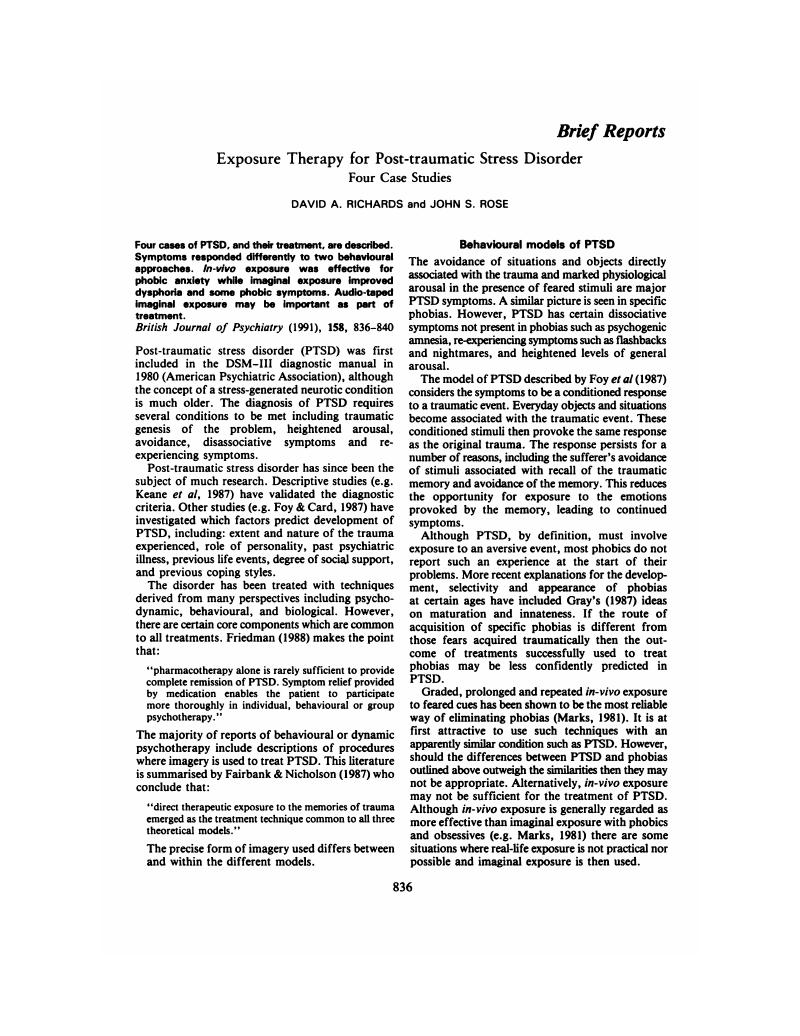Crossref Citations
This article has been cited by the following publications. This list is generated based on data provided by Crossref.
Fisher, Nigel
and
Jacoby, Robin
1992.
Psychiatric morbidity in bus crews following violent assault: a follow-up study.
Psychological Medicine,
Vol. 22,
Issue. 3,
p.
685.
Aghabeigi, B.
Feinmann, C.
and
Harris, M.
1992.
Prevalence of post-traumatic stress disorder in patients with chronic idiopathic facial pain.
British Journal of Oral and Maxillofacial Surgery,
Vol. 30,
Issue. 6,
p.
360.
Bisson, Jonathon I.
and
Jones, Norman
1992.
Drug therapy of post-traumatic stress disorder.
British Journal of Psychiatry,
Vol. 161,
Issue. 1,
p.
130.
Blore, David C
1993.
Treating a miner with underground phobia.
British Journal of Nursing,
Vol. 2,
Issue. 20,
p.
1017.
Spector, John
and
Huthwaite, Mark
1993.
Eye-Movement Desensitisation to Overcome Post-traumatic Stress Disorder.
British Journal of Psychiatry,
Vol. 163,
Issue. 1,
p.
106.
ADSHEAD, GWEN
CANTERBURY, RACHEL
and
ROSE, SUZANNA
1994.
Current provision and recommendations for the management of psychosocial morbidity following disaster in England.
Criminal Behaviour and Mental Health,
Vol. 4,
Issue. 3,
p.
181.
Richards, David A.
Lovell, Karina
and
Marks, Isaac M.
1994.
Post-traumatic stress disorder: Evaluation of a behavioral treatment program.
Journal of Traumatic Stress,
Vol. 7,
Issue. 4,
p.
669.
Yule, William
and
Canterbury, Rachel
1994.
The treatment of post traumatic stress disorder in children and adolescents.
International Review of Psychiatry,
Vol. 6,
Issue. 2-3,
p.
141.
Hughes, Jamie G. H. Hacker
and
Thompson, James
1994.
Post traumatic stress disorder: An evaluation of behavioural and cognitive behavioural interventions and treatments.
Clinical Psychology & Psychotherapy,
Vol. 1,
Issue. 3,
p.
125.
Davison, F M
Clare, I C H
Georgiades, S
Divall, J
and
Holland, A J
1994.
5. Treatment of a Man with a Mild Learning Disability Who was Sexually Assaulted Whilst in Prison.
Medicine, Science and the Law,
Vol. 34,
Issue. 4,
p.
346.
Wykes, Til
and
Mezey, Gillian
1994.
Violence and Health Care Professionals.
p.
207.
Allen, Judith
Cassidy, Cahill
and
Monaghan, Clare
1994.
A community mental health team in Northern Ireland: new referrals as a result of civil disorder.
Irish Journal of Psychological Medicine,
Vol. 11,
Issue. 2,
p.
67.
Richards, David
1994.
Traumatic stress at work: A public health model.
British Journal of Guidance & Counselling,
Vol. 22,
Issue. 1,
p.
51.
Yule, William
1994.
International Handbook of Phobic and Anxiety Disorders in Children and Adolescents.
p.
223.
Richards, David A.
Lovell, Karina
and
Marks, Isaac M.
1994.
Post‐traumatic stress disorder: Evaluation of a behavioral treatment program.
Journal of Traumatic Stress,
Vol. 7,
Issue. 4,
p.
669.
Vaughan, K.
Wiese, M.
Gold, R.
and
Tarrier, N.
1994.
Eye-Movement Desensitisation.
British Journal of Psychiatry,
Vol. 164,
Issue. 4,
p.
533.
Chung, Man Cheung
1995.
Reviewing Frankl'swill to meaningand its implications for psychotherapy dealing with post‐traumatic stress disorder.
Medicine and War,
Vol. 11,
Issue. 1,
p.
45.
Thompson, James
Chung, Man Cheung
Jackson, Gary
and
Rosser, Rachel
1995.
A comparative trial of psychotherapy in the treatment of post‐trauma stress reactions.
Clinical Psychology & Psychotherapy,
Vol. 2,
Issue. 3,
p.
168.
Regel, Stephen
and
Davies, John
1995.
The future of mental health nurses in liaison psychiatry.
British Journal of Nursing,
Vol. 4,
Issue. 18,
p.
1052.
Foreman, Elaine Iljon
and
Hough, Alexandra
1995.
Physiotherapy in Mental Health.
p.
341.




eLetters
No eLetters have been published for this article.